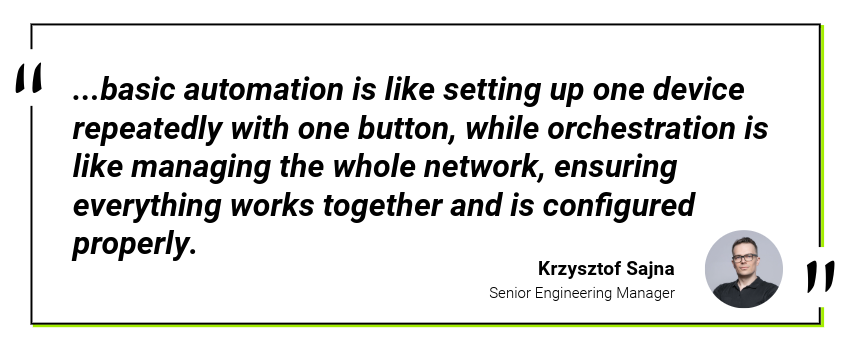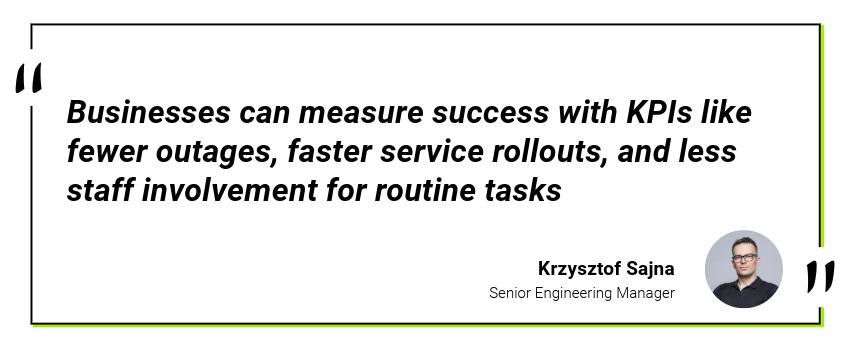To help us understand the growing importance of service orchestration in today’s networks, we spoke with Krzysztof Sajna, Senior Engineering Manager at CodiLime. With over 13 years of experience leading complex software and hardware projects across various industries, Krzysztof brings both strategic and practical insights into what it takes to implement orchestration successfully. In this conversation, we discuss how orchestration helps companies manage complexity, scale efficiently, and align technical operations with business goals.
Why is orchestration needed?
Benjamin: Thanks for sitting down with me today, Krzysztof. To start with, I think everyone reading this can agree that networks are becoming more and more complex, but what some of us might not know is how orchestration fits in. Could you tell me what specific operational challenges orchestration addresses in managing large-scale complex networks that span multiple vendors and technologies?
Krzysztof: No problem, I am always happy to chat about network orchestration. And yes, you’re definitely right about networks being more complex nowadays, however, network orchestration addresses key challenges in managing large-scale, multi-vendor networks by centralizing control and automating workflows. It simplifies operations by coordinating configuration, provisioning, and management across diverse technologies, reducing complexity and improving scalability. For example, it ensures seamless integration in hybrid environments, like on-prem and cloud setups, making it easier to add new devices or services without manual effort.
Benjamin: That integration between environments seems really important, especially as businesses continue to move toward hybrid and multi-cloud setups. Orchestration seems to reduce not only effort but risk as well.
Speed, agility, and real-time responses
Benjamin: Let’s talk about speed. How does orchestration help service providers roll out new services faster or respond more quickly to customer demands, compared to traditional manual processes?
Krzysztof: Orchestration likely enhances service providers' agility by automating processes, such as user additions, which can be done swiftly with accurate settings. This automation reduces rollout times for new services and speeds up responses to customer demands, compared to manual methods, especially in fast-evolving networks like 5G.
Benjamin: So for telecoms this is especially important, where the pace of change is relentless.
Misconceptions and common pitfalls
Benjamin: What are some of the biggest misconceptions you see around orchestration? Are there any common mistakes businesses make when they’re just starting out?
Krzysztof: I would say that common misconceptions include thinking orchestration is merely automation; it's actually way more comprehensive, involving end-to-end coordination. Businesses might face pitfalls like underestimating integration needs or lacking skills, which can hinder implementation. Managers should be aware of these to avoid costly mistakes.
Benjamin: That distinction between automation and orchestration is really important, so perhaps we should unpack that for our readers who may not come from a technical background.
Automation vs orchestration
Benjamin: If you had to explain the difference between automation and orchestration to someone non-technical, let’s say a business stakeholder, how would you put it?
Krzysztof: For someone unfamiliar with the tech side of things, basic automation is like setting up one device repeatedly with one button, while orchestration is like managing the whole network, ensuring everything works together and is configured properly. This distinction matters because it helps organizations scale and adapt, aligning with business goals and improving efficiency.

Benjamin: That’s a great analogy; it really shows how orchestration lets you move from individual actions to system-level outcomes. And scaling with confidence is something every business is looking for.
Organizational shift
Benjamin: Once companies commit to orchestration, it’s not just the tech that needs to change. What kinds of organizational or process adjustments should they be ready for?
Krzysztof: Beyond tech, companies likely need to streamline their operational models focusing on centralized automation within their existing network infrastructure. Managing these changes requires clear communication, training to reduce resistance, and partnering with experts for custom solutions, ensuring successful adoption.
Benjamin: So leadership, communication, and change management all play a key role in orchestration initiatives, just as much as the software or architecture behind it.
KPIs and ROI
Benjamin: Once orchestration is in place, how can a business measure whether it’s delivering the expected value? What kind of KPIs should they be tracking?
Krzysztof: Businesses can measure success with KPIs like reduced service deployment times, fewer network outages, a self-service approach, and less involvement of staff for routine changes. These metrics show if orchestration delivers value, though exact targets may depend on the organization's context.

Benjamin: That makes it easier to connect engineering success to business outcomes. Whether it’s fewer outages or faster time-to-market, those are results any team can appreciate.
Managing expectations and adapting to change
Benjamin: One final question; beyond the tech, how do managers keep projects on track in fast-moving environments like 5G? Any lessons from your experience?
Krzysztof: From a manager's view, communicating with clients is crucial to manage expectations and prevent scope creep, using formal change controls. Rapid tech evolution, like 5G advancements, requires flexibility, staying informed, and adapting plans, while clear communication and training help navigate these challenges.
Benjamin: Absolutely. Flexibility and communication seem to be the common thread running through every successful implementation. Thank you, Krzysztof, for sharing your experience and insights. I’m sure this will help both technical and business readers better understand what orchestration can do, and what it takes to actually do it well.








